Last Updated on July 21, 2023 by Rod Olivares
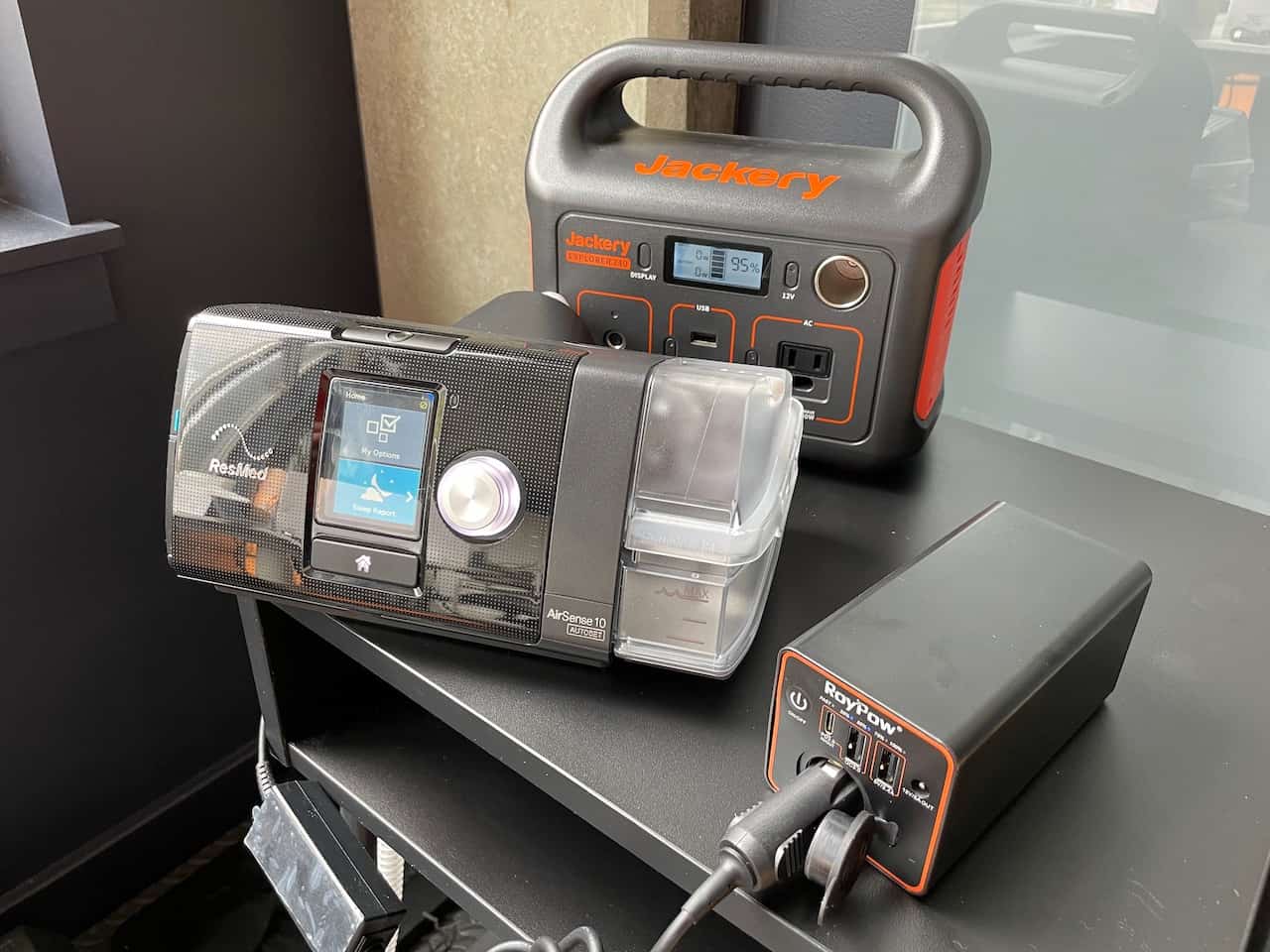
For those with sleep apnea, camping trips can prove to be a challenge as not all campsites have electrical hookups. This draws many CPAP users away from the outdoor experience of camping and back home or into their apartment where they know that their machine has its power supply readily available.
But this doesn’t need to stop you!
With CPAP batteries for your CPAP machine, you’ll never have trouble getting a quality night’s sleep outside again! I’m going to walk through my top CPAP battery pack choices in order so that whoever reads this will find the perfect solution for next time’s trip into nature.
It’s also worth mentioning, that even at home you just never know when the power will go out – even if it’s for a few hours! So it doesn’t hurt to have a backup generator inside your apartment for potential emergencies.
Tips For Running a CPAP on a Battery
But first, there are two main tips to lower the power draw of your CPAP machine each night:
Remove any humidifier
If you can, remove or disable the humidifier part of your CPAP. This draws the most amount of power from your system so if possible avoid using one at all costs!
Use DC power
Find a DC adapter for your device that plugs into a cigarette 12v lighter port. Using the DC output on your battery generator will draw fewer watts vs the AC outlet and you’ll get more hours from your battery pack.
A CPAP like the Resmed10, with humidifier off and the climate-line hose to 74°F, and airplane mode on will draw around 8 watts from a portable CPAP battery. So on smaller CPAP batteries like the Jackery 160, you’d get a full night’s sleep but may need to charge during each day. Larger battery packs like the Jackery 300 or Anker Powerhouse II would give you 3-5 nights of sleep with your CPAP between charging.
CPAP Machines and Compatible Batteries
These portable batteries will work with popular CPAP devices like the ResMed AirSense 10 CPAP, Philips Respironics DreamStation Go, and the Z2 Auto Travel CPAP Machine but you will likely need a special power adapter to connect the CPAP to the 12v cigarette output on the battery pack. You can use the AC wall outlet on each portable battery, but running on 12V DC power will make your CPAP battery last longer.
In my testing with my ResMed, I saved about 5 Watts using DC power with an adapter vs AC power.
Best CPAP Battery: EcoFlow River 600
The killer feature of the Ecoflow River 600 for a CPAP battery is how quickly it recharges. You can re-charge the battery in just one hour. It’s crazy fast how quickly it can charge. It has enough capacity for 1-2 nights of CPAP usage, and it’s my go-to battery pack for anything under 500Wh.
See my video as I review all my best CPAP battery options:
Runner-up CPAP Battery Pick: Jackery Explorer 300
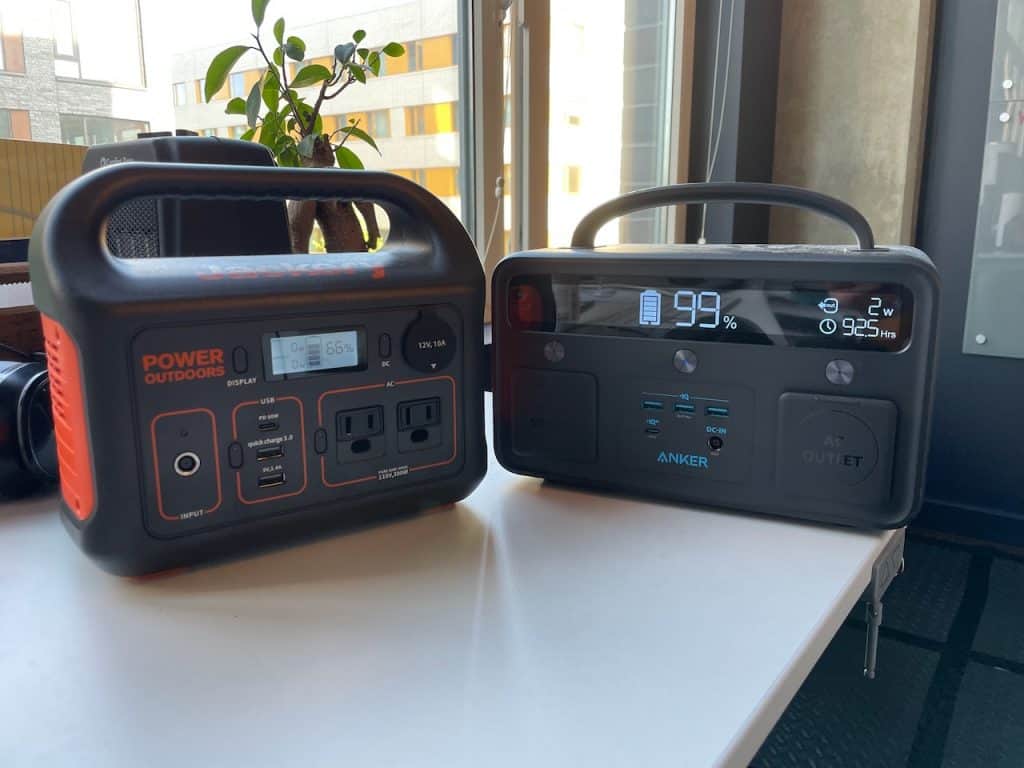
One of the newest Jackery models, the 300 is my favorite power station. I take it to coffee shops and keep it by my bed to charge my devices at night. It has a 12-hour auto-shutoff for power draws under 10W, so it’s perfect for a low-power CPAP. With 293 Wh of capacity, you should easily get overnight usage from your CPAP with the 300.
The Jackery 300 has a built-in 12V cigarette adapter port, so you won’t need the extra dongle adapter that you need on the 160. This CPAP battery also works great during a power outage to power mobile devices, as it comes with two USB ports, a 60W USB-C port, and two AC power outputs.
Another Premium Backup Battery: The Anker Powerhouse II
Another premium pick, with a built-in nightlight that I really like, is the Anker Powerhouse II. With even more capacity than the Jackery 300, you’ll never worry about your CPAP shutting off at night. It is a bit heavier but comes with 388 Wh of capacity. Both the Anker and Jackery 300 comes with a 60W out USB-C port, which is great if you have a small laptop or another USB-C device.
Best CPAP Battery Pack for Camping
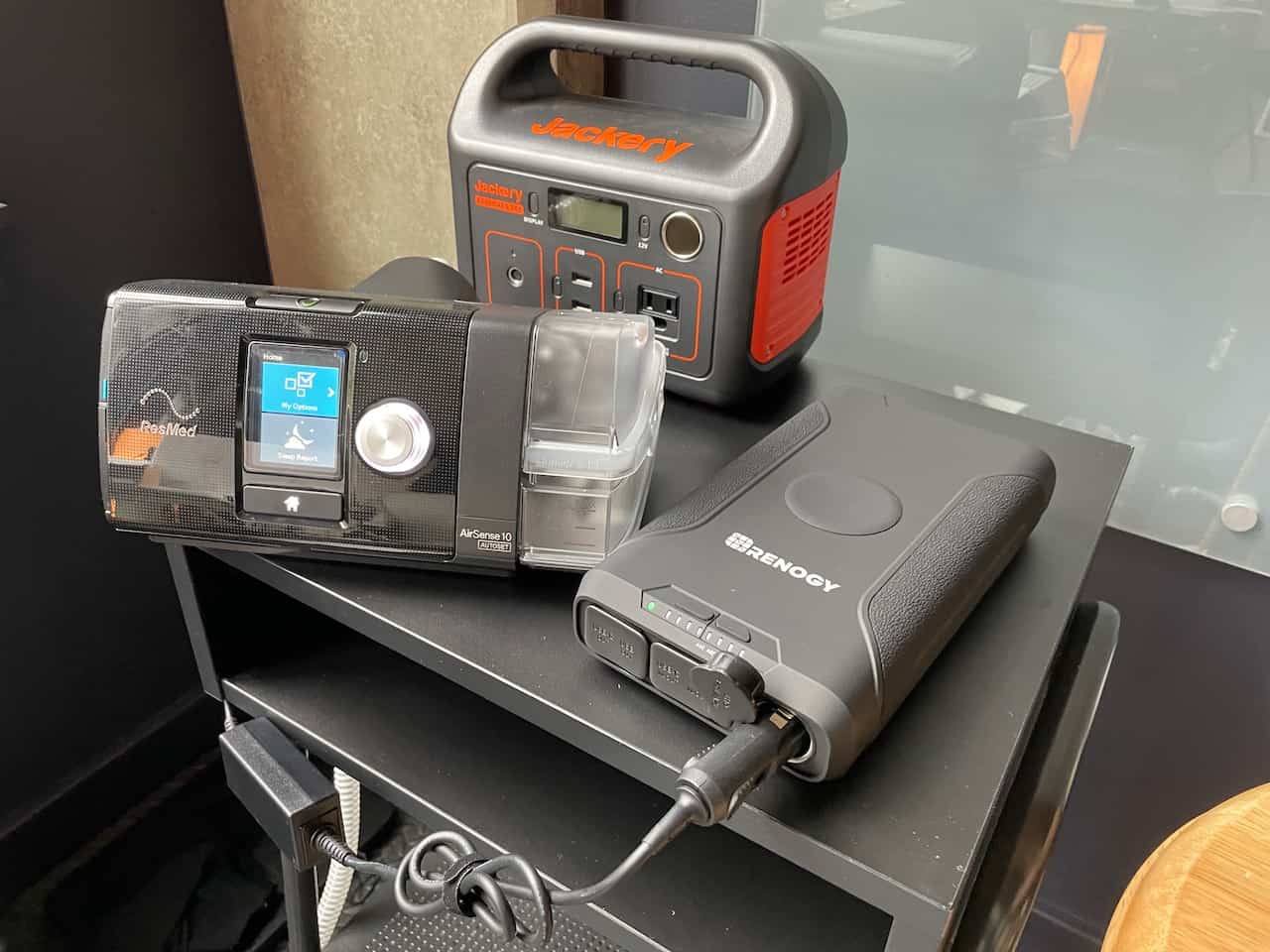
If I was camping or backpacking and didn’t have to fly, I would grab the Renogy 12v Power Bank. It has a 12v outlet for a cigarette-style input that can power most CPAPs with an adapter. Not having to rely on an AC port allows a much more compact battery pack, and DC power will draw less Watts from your battery back, allowing you to power your CPAP device longer. This capacity should easily last an 8-hour night out in the woods and has a nice wireless charger on the top of the pack that I really like.
Low Power Nap Battery Pick: Jackery Explorer 160
Jackery is an industry leader when it comes to portable battery backup, and the Explorer 160 is a great CPAP backup battery that may not last a whole night but would get close. While the 160 is an older model than the 300 (my favorite Jackery model!) – its price point is half the more expensive 300 model. Both offer AC Power and DC power for your CPAP machine.
The small size of the 160 shouldn’t fool you: this generator produces enough wattage to power your CPAP machine and other small appliances you may need while camping. Weighing in at only 3.84lbs, this unit includes a built-in handle that allows for easy carrying on any trip – whether indoors or outdoors!
If your CPAP draws on the lower end of wattage, say 15W per hour, you could still get a full nights sleep with the 160.
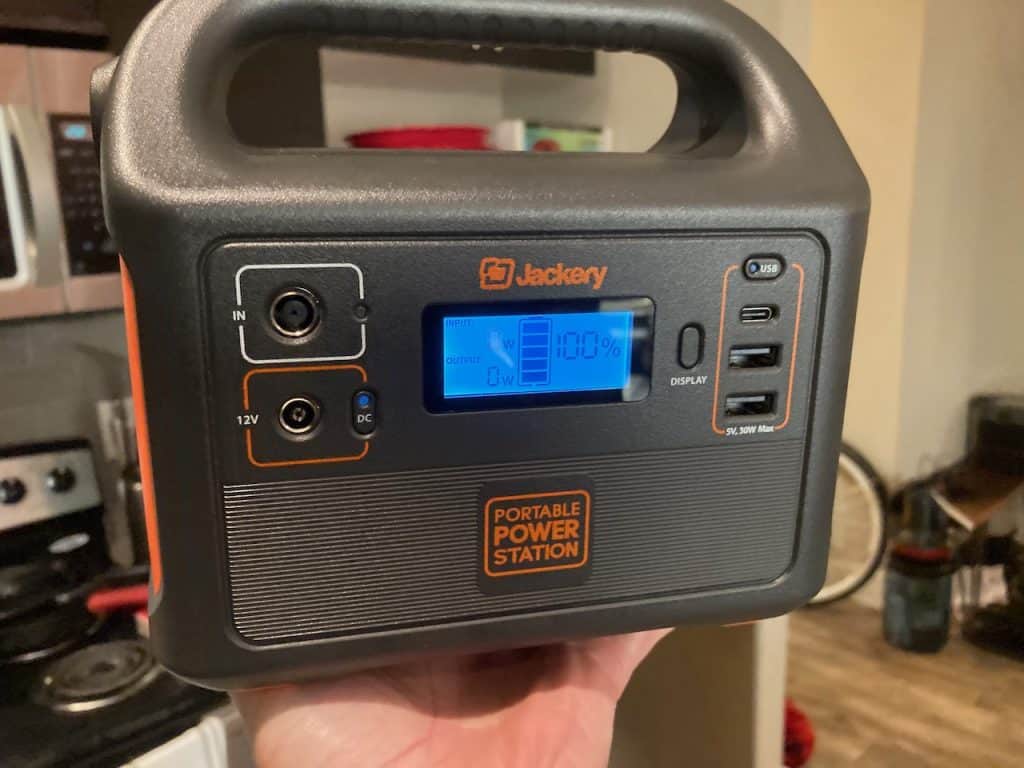
It is small enough to fit in most backpacks and offers three different charge methods – solar panel, household outlet, and cigarette lighter. If you suffer from sleep apnea, this very portable CPAP battery backup is a perfect option to power your CPAP machine anywhere in the world.
At 167Wh, it is over the 100Wh TSA approved limit for carry-on air travel lithium-ion batteries, but it is a good option if you are not flying with your CPAP device.
The Jackery Explorer 160 features:
- Cell type: Li-NMC
- Pack capacity: 167Wh
- LCD info screen
- Weight: 3.84 lbs
- Power pack dimensions – 7.4” x 4.5” x 6.7”
- Built-in LED flashlight
- 1 – USB-C port
- 2 – USB-A ports
- 1 – 12V DC output 6mm
- 1 – charging input 8mm
Jackery offers a 2-year warranty on all of its portable battery generators.
The Jackery Explorer 160 charge times:
- Wall charger (45W): 5 hours
- Car charger (30W): 5 hours
- Solar panel: 8-10 Hours
The Jackery Explorer 160 can charge:
- Smartphones – 12+ times
- Tablets – 5+ times
- Cameras – 20+ times
- Laptops – 2+ times
- Mini Fridges – 3+ hours
- Drones – 2+ times
- USB small fan – 26+ hours
Pros
- Very lightweight
- Quick charge time
- Easy to carry
Cons
- No cigarette lighter input
IMHO: In My Humble Opinion
When it comes to a Jackery power station, it is hard to find any reason not to go with one. The quality is unmatched, and with this Explorer 160, you can easily power up any CPAP machine and still power many of your other devices with ease.
One note on CPAP usage, the Jackery 160 will automatically turn off after 6 hours in you are drawing less than 10 watts of power. Depending on your CPAP machine, you may be just under that level. There isn’t a way to turn this feature off, so I would suggest plugging in another small device to draw a few more watts to make sure you aren’t woken up at the 6-hour mark.
See my full review of the Jackery Explorer 160 and how it compares to the Goal Zero Yeti 200x.
Official CPAP Batteries vs Generic Li-Ion Batteries
The advantage of buying an official CPAP battery backup like a:
- DreamStation Go Overnight Battery
- EXP48 Pro Lithium Ion Battery Bank
- Medistrom Pilot-24™ Lite Battery
- BPS Freedom V2 Travel CPAP Battery
is that these portable CPAP batteries will not require an extra DC adapter. They all have plugs that will natively work with your CPAP device. The other advantage is they are all under 100Wh, so you can take them on an airplane.
The downside to these official CPAP batteries is that they are grossly overpriced for their Wh (watt-hour) capacity compared to more generic battery backups. Also, an official CPAP battery will only contain at most 1 extra USB port, if any, so you are limited to using the battery exclusively for your CPAP.
Generic backup batteries however have a much better runtime per dollar. The DreamStation Go for example only has a 62 Wh capacity, at $300, you can find the Jackery 300 for that price that has nearly 5x the capacity at 293 Wh.
My Budget Airline Travel CPAP Battery Backup: RoyPow Portable Charger with 12V/10A Cigarette Lighter Socket
As one of the cheapest portable CPAP battery picks, you will get limited capacity with the RoyPow, but its small size makes it perfect for when you are flying. It is under the 100 Wh limit for TSA approval, so you can take this to power your CPAP on your carry-on bag. Would work for a good couple of hour nap on the plane at least!
Pros
- Lightweight
- Cigaratte output port
- Cheap
Cons
- No-name brand
- Limited backup capacity
Frequently Asked Questions
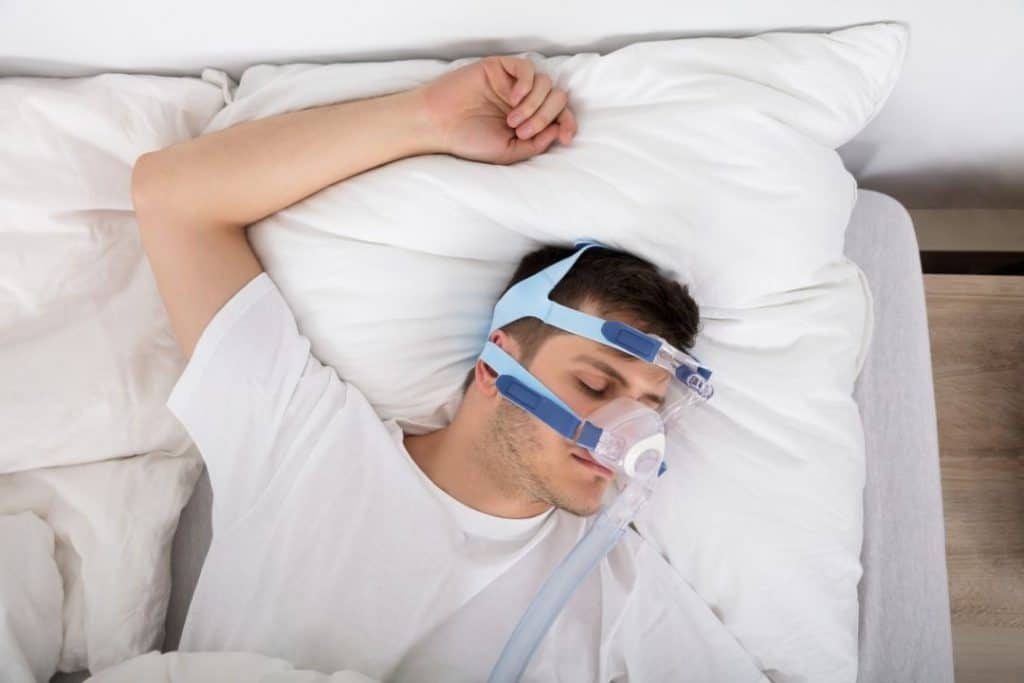
How many watts does a CPAP machine use on Battery?
My CPAP, a Resmed Airsense 10 model, uses 20 to 30 watts with the humidifier turned off. The device ranges from about 20-30 watts depending on pressure and how I breathe. Running for an hour test, the device used 10% capacity of a Jackery 300 battery pack. That pack has 293Wh, so the usage was about 30Wh. This means to run for 10 hours, you would need a 300Wh capacity battery pack.
How loud is a CPAP battery?
The portable power supplies I selected for the purpose of this article are battery or solar-powered, which means they do not have noisy engines and will operate quietly enough to have in the tent with you when camping. In most cases, the CPAP machine is going to be louder than your portable power supply.
If you are using a gas-powered generator, you will need to run an extension cord to your machine as the generator will need to be outside of your RV or tent.
Also see my list of the quiet gas powered generators that are good for camping when you have neighbors near by your campsite.
How can I safely use a CPAP battery when camping?
Since all these CPAP batteries are battery and not gas or propane powered, you will not have to worry about harmful gases being emitted from the power supply. For these backup battery packs, you are going to want to make sure that you keep the battery dry and out of direct sunlight (minus any solar panels you are using to charge them!) to ensure that you are not exposing the battery to high heat or wet conditions as this can cause damage.
I hope this guide has helped you get a better understanding of the different options available for CPAP batteries. If you have any questions, please don’t hesitate to email me at scott@kragerlabs.com and I will be happy to answer them!
GeneratorGrid.com is an independent review business. I am not affiliated with any manufacturers and do not accept paid reviews. When you buy through my links, I may earn a commission which helps me purchase more generators for testing. - Scott Krager

